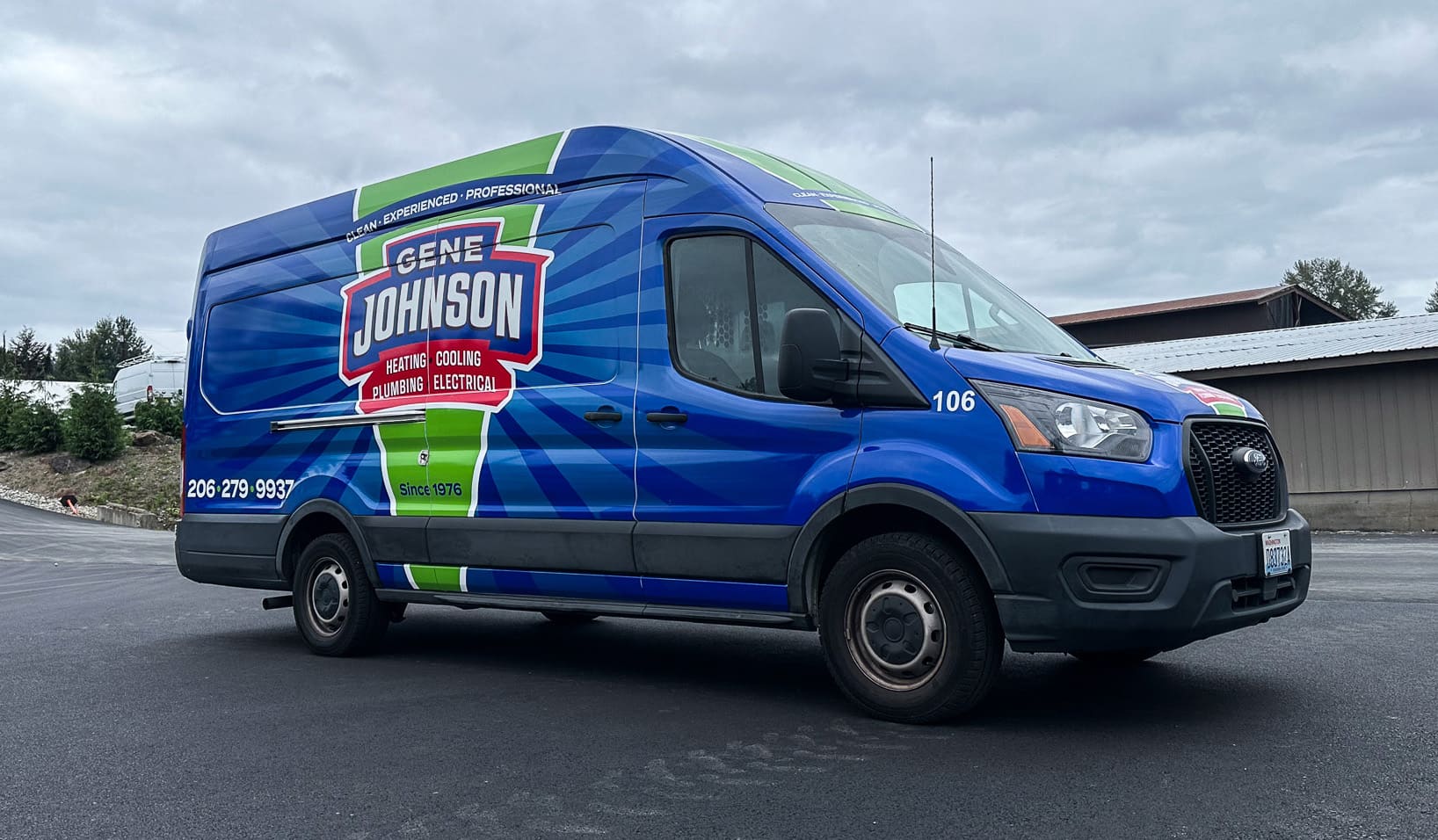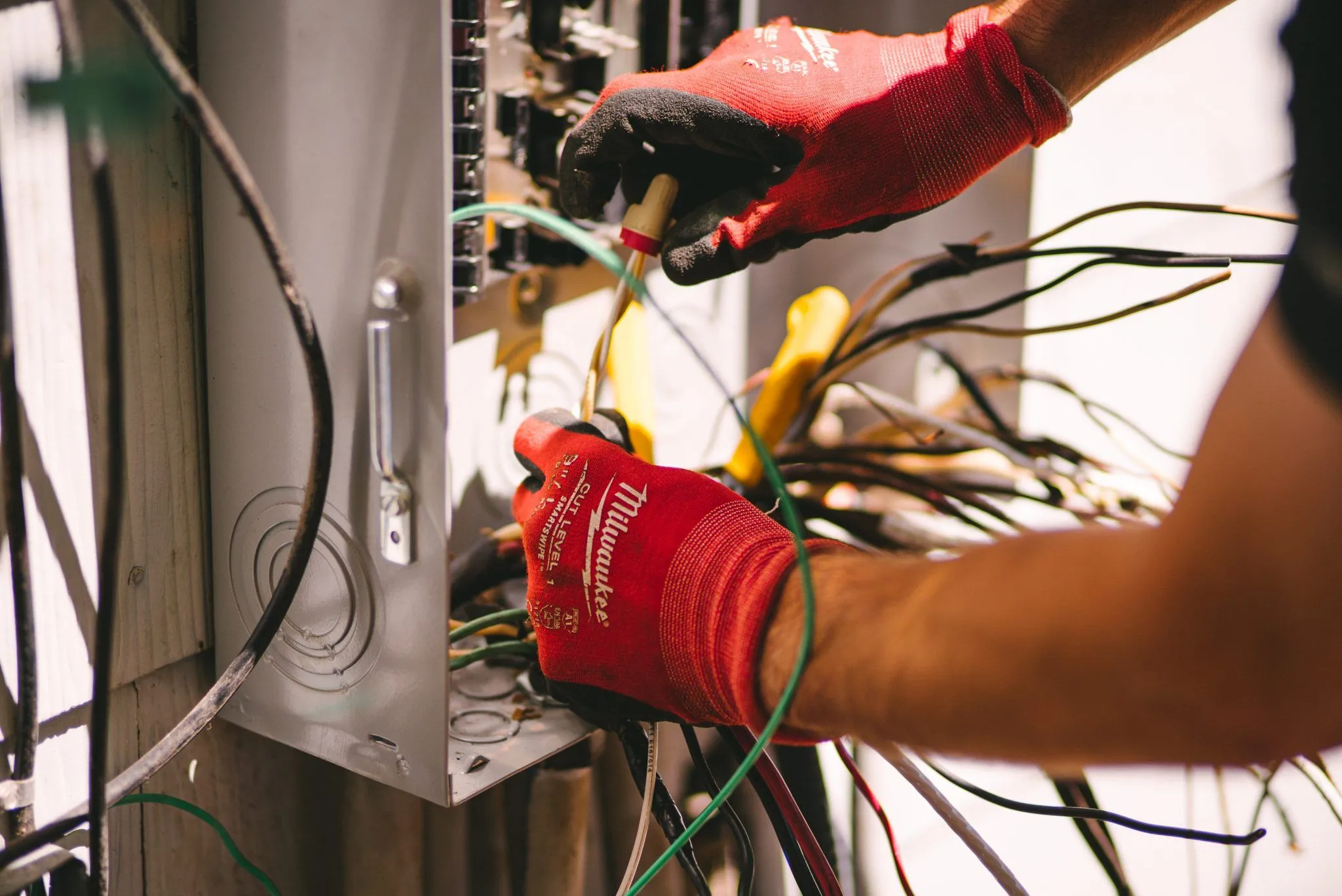Drain Camera Scoping
When stubborn clogs or persistent backups turn your plumbing system into something resembling an underground labyrinth, it’s time to bring in a vision system built to navigate the depths. Don’t resign yourself to costly excavations and disruptive guesswork – invest in the clarity of professional drain camera scoping from Gene Johnson instead.
Our certified technicians leverage cutting-edge fiber-optic camera equipment to visually inspect and diagnose the condition of your residential or commercial drainage network with unparalleled precision. Whether plumbing issues lurk deep within main sewer lines or remain hidden behind walls and landscapes, our tech-driven scoping services illuminate problems with high-definition clarity.
With four decades of drainage mastery in Seattle, WA and across Western Washington, we’ve built a reputation for quickly pinpointing root causes and engineering comprehensive solutions – not just applying band-aid fixes. When you deserve true transparency into what’s afflicting your pipes, Gene Johnson answers the call with an eagle-eye perspective that brings your system into sharp focus.
Stop flushing time and money down the drain battling recurring plumbing headaches. Illuminate the unknown through professional drain camera scoping by calling the Seattle, WA experts at (206) 792-7495 today.
$375 OFF
Clean Air Package (Air Purifier, Duct Cleaning, Blower Wheel Cleaning & Filter)
Cannot be combined with any other offers or discounts. Coupon must be presented at time of payment. Not valid for trip charge or diagnostic fee. Valid on standard pricing only. Redeemable for one-time use per home.
$89
Plumbing Safety Inspection
Cannot be combined with any other offers or discounts. Coupon must be presented at time of payment. Not valid for trip charge or diagnostic fee. Valid on standard pricing only. Redeemable for one-time use per home.





Drain Camera Scoping FAQ
What is Drain Camera Scoping?
The Benefits of Drain Camera Scoping
Is Drain Camera Scoping Safe for All Types of Pipes?
How Accurate is Drain Camera Scoping?
Can Drain Camera Scoping Identify All Types of Pipe Issues?
Can I DIY Drain Camera Scoping?
What Should I Expect During a Drain Camera Scoping Process?
How Long Does a Drain Camera Inspection Typically Take?
How Often Should Drain Camera Scoping Be Done?
Are Special Preparations Needed Before a Drain Camera Inspection?
What Happens If a Problem Is Discovered During Scoping?
Is Drain Camera Scoping Suitable for Emergency Situations?
What is Drain Camera Scoping?
Drain camera scoping represents the cutting edge of comprehensive plumbing diagnostics. This innovative service deploys sophisticated fiber-optic camera equipment to visually inspect and evaluate the condition of your property’s entire drainage system – from primary sewer lines to interior piping networks.
Rather than relying on guesswork to locate clogs, root intrusions, pipe damage, or other obstructions, drain camera scoping illuminates the subterranean unknown with crystal-clear video footage. Technicians maneuver remotely-controlled, high-resolution cameras through drain lines, capturing real-time video feeds while tracking the precise location of any identified issues.
This advanced visual data provides an unprecedented look into areas typically inaccessible through any other inspection method. Every inch of piping, from sewer main connections to interior branch lines, gets thoroughly scoped out without any destructive digging or demolition required.
Gene Johnson’s certified drain camera experts leverage this technology to pinpoint problematic pipe sections with laser-exact precision. Through comprehensive video evidence, they can then architect and execute targeted repairs or replacements with zero guesswork involved.
Whether persistent backups have you feeling backed into a corner, or you’re being proactive about maintaining aging drainage infrastructure, professional drain camera scoping services are the modern solution to bringing your piping network into clear focus. Say goodbye to blind diagnoses and hello to a vision-driven grasp of your system’s true condition.
The Benefits of Drain Camera Scoping
By leveraging cutting-edge video technology for complete visibility into your drainage system’s condition, professional drain camera scoping provides a multitude of advantages over old-school inspection methods:
Locate Problems Precisely
Don’t waste time and money blindly troubleshooting or taking stabs in the dark. Scoping cameras zero in on the exact locations of clogs, cracks, misalignments, and other obstructions with video evidence. No more guessing games.
Minimize Destruction
Traditional methods, like digging up landscapes or demolishing interior walls to access pipes, are incredibly disruptive and costly. Camera inspections are non-invasive, with no damage to your property required.
Reveal Uninspectable Areas
Even the most thorough manual inspection can’t uncover issues lurking within underground sewer mains or piping tucked behind surfaces and foundations. Scoping cameras can.
Diagnose Root Causes
Rather than just treating symptoms, video feeds allow technicians to get an inside look at what’s actually causing backups or flow problems – whether it’s accumulated debris, root intrusions, bellied pipes, or structural damage.
Document Findings
With recorded video evidence, you get clear documentation of your system’s condition to reference for future maintenance needs or share with other professionals when repairs are required.
Versatile Applications
Camera scoping pinpoints all types of issues across residential and commercial properties – from minor clogs to catastrophic sewer line failures. No drainage problems are out of its scope.
By providing comprehensive visibility instead of blind diagnostics, professional drain camera inspections are the modern solution for taking a proactive, evidence-based approach to maintaining your drainage system’s health and longevity.
Is Drain Camera Scoping Safe for All Types of Pipes?
When navigating your property’s pipes and drainage infrastructure with high-tech camera equipment, safety undoubtedly becomes a paramount concern. After all, you’ve invested substantially in those plumbing networks – the last thing you need is an overly aggressive inspection method causing inadvertent damage.
Fortunately, drain camera scoping represents one of the lowest-risk, non-invasive diagnostic techniques available in modern plumbing. Technicians utilize a gentle, almost surgical approach to threading self-propelled, fiber-optic cameras deep into even your system’s most delicate pipework.
Versatile Applications Across All Materials
Designed for maximum maneuverability and toughness, drain cameras can safely navigate piping composed of any material:
- Clay and cast iron – Common in older properties
- PVC and ABS plastic – Standard for modern construction
- Copper piping – Often used for interior water supply branching
- Concrete and masonry drainage structures
The smooth, lubricated passage of these waterproof, mobile cameras simply cannot impart the kind of excessive force, scraping, or blunt impacts that could compromise a pipe’s structural integrity.
Specialized Lens Housings Eliminate Snags
Even when navigating tight 90-degree angles, offsets, or invasive root masses within your drainage system, drain cams deftly maneuver with their flexible, low-profile lens housings and balanced weight distribution. You’ll never have to worry about equipment binding, snagging, or becoming stuck inside lines.
If any obstructed sections do prevent full camera passage, that simply indicates a larger accessibility issue technicians need to address – not damage caused by the inspection itself.
Exhaustive Technician Training
In addition to relying on robust technological safeguards, you can feel confident knowing only the most highly trained, certified professionals from Gene Johnson conduct drain camera scoping on your property.
These plumbing experts undergo extensive instruction on properly deploying inspection cameras while upholding industry best practices and safety protocols. They approach every job with the utmost care and meticulous technique honed over decades of experience.
From fragile historic clay pipes to modern PVC networks, you can rest assured knowing professional drain camera scoping provides an invaluable diagnostic glimpse into your system’s condition without compromising its longevity through improper methods. Safety, and preserving your plumbing investment, are always the top priority.
How Accurate is Drain Camera Scoping?
In a world of plumbing diagnostics previously dominated by educated guesswork and blind remedies, drain camera scoping has ushered in a new era of unparalleled precision. But just how accurate are these state-of-the-art video inspections at pinpointing drainage system issues?
The short answer – they are incredibly accurate, down to the inch. Here’s a deeper look at the technology behind this diagnostic precision:
High-Resolution Visibility
Long gone are the days of relying on low-quality, grainy camera feeds to discern pipe conditions. Modern drain scoping deploys high-definition cameras capable of rendering minute details with startling clarity. Hairline fractures, displaced joints, mineral buildup – no flaw goes undetected.
Sewer Line Footage Tracking
As inspection cameras journey through your drainage network, integrated transmitters constantly track and map their precise location and footage in real-time. This allows technicians to pinpoint problem areas down to the specific pipe section and depth for targeted repairs.
Panoramic Lens Perspectives
Specialized plumbing videoscopes feature multiple lens views and lighting accessories to provide comprehensive visibility from all angles inside pipes. Pan-and-tilt capabilities, along with zoom functions, ensure no issues escape inspection, regardless of perspective limitations.
Real-Time Monitoring and Recording
Highly trained technicians don’t just set cameras into motion blindly. They vigilantly monitor and annotate video feeds live as inspections occur, tracking any identified problems. This real-time visual data gets compiled into permanent recordings for future analysis.
Simply put, drain camera inspections eliminate the uncertainty of blind diagnoses by providing an unobstructed, comprehensively documented perspective into your drainage system’s condition. You receive factual video evidence of any issues, their precise locations, and the proper remedies required – all with incredible pinpoint accuracy.
It’s this capability to finally “see” what’s really happening within those subterranean pipe networks that allows plumbers to engineer truly effective, lasting solutions rather than chasing their tails through trial-and-error. When it comes to drainage diagnostics, accuracy is everything.
Can Drain Camera Scoping Identify All Types of Pipe Issues?
With the power to visually inspect every inch of your drainage system, rendering crisp high-definition footage, one might assume professional drain camera scoping holds the ultimate diagnostic perspective for pinpointing any plumbing problems. But does this technology truly illuminate the full spectrum of potential pipe afflictions?
The resounding answer is…not quite. While undeniably the most comprehensive diagnostic tool available, even cutting-edge drain cameras have their limitations in detecting certain types of issues. Understanding what they can and cannot identify allows you to approach inspections with realistic expectations.
What Drain Cameras Readily Expose:
- Obstructions from debris buildup, roots, objects
- Cracks, fractures, and holes in pipe walls
- Misaligned, offset, or protruding pipe joints
- Bellied/sagging sections collecting water
- Infiltrating groundwater from leak sources
- Corrosion or mineral buildup along pipe walls
As you can see, this digital eye in the pipeline shines a spotlight on the most common culprits behind recurring clogs, sewage backups, and overall flow problems. If there are physical impediments or structural deficiencies, the camera captures definitive evidence.
What May Remain Hidden:
- Pipe composition/material issues
- Nominal, slower leak sources before pooling
- Infiltrating external odors prior to major leaks
- Pipes under pressure prior to failure
- Non-structural operational issues like pump failures
So, while drain cameras showcase deteriorated pipe conditions requiring repairs/replacements, they can’t necessarily diagnose system design flaws, material incompatibilities, or determine which components may be nearing the end of their life cycle.
This is why comprehensive drain scoping inspections involve far more than just inserting a camera. Skilled technicians also assess related plumbing equipment, conduct hydrological testing, and cross-reference video evidence alongside their deep domain expertise before making diagnoses.
Does a camera see everything? Not quite. But when leveraged properly alongside other diagnostic techniques by certified professionals, drain scoping provides an undeniably unparalleled perspective for identifying underlying pipe pathologies – a perspective you simply can’t achieve through any other method. Gene Johnson always maximizes this powerful technology’s full capabilities.
Can I DIY Drain Camera Scoping?
With HD cameras seemingly integrated into every modern device these days, you may be tempted to save money through a do-it-yourself approach to drain inspections. After all, how difficult could navigating pipes with a tiny snake camera really be?
While the intrepid DIY spirit is admirable when tackled responsibly, attempting to self-perform comprehensive drain camera scoping is simply ill-advised – and potentially unsafe – for several crucial reasons:
Lack of Proper Equipment
Those basic household cameras or inspection scopes from the hardware store pale drastically in comparison to the specialized, purpose-built pipeline videoscopes professionals utilize. This state-of-the-art gear features:
- Integrated sewer line transmitters for tracking locations
- Panoramic multi-lens systems for complete visibility
- Rugged, waterproof deployments rated for harsh conditions
- Extended range and mobility within drain lines
- High-intensity lighting components for crisp footage
Simply put, amateur cameras lack the full capabilities to thoroughly inspect and document your drainage system’s condition to diagnostic standards.
Dangers of Improper Technique
Even with the right equipment, attempting blind camera insertions requires extensive training and experience that professionals possess. Forcing equipment haphazardly into piping risks:
- Getting cameras irretrievably stuck in obstructed lines
- Damaging delicate pipe sections through heavy-handed techniques
- Exposure to hazardous sewer gasses if proper line ventilation isn’t implemented
- Inability to troubleshoot issues or dislodge snags when they occur
Compromising the integrity of your drainage infrastructure through improper scoping methods can easily compound into costlier repair needs down the line.
Missing the Larger Diagnostic Picture
Conducting a drain camera inspection alone only reveals part of your system’s condition. Trained technicians synthesize that video data alongside comprehensive assessments of related equipment and operational testing to formulate effective remedies – something amateurs lack the expertise to execute properly.
While the prospect of saving money initially may spark DIY interest, ultimately there’s no replacement for the comprehensive training, cutting-edge equipment capabilities, and diagnostic mastery that certified plumbing professionals leverage through drain camera inspections. Amateurs simply cannot achieve the same level of thorough, insightful, and safe results.
For an invaluable glimpse into what’s really transpiring behind the scenes of your drainage network, professional scoping services represent a wise investment in preserving your system’s longevity. Gene Johnson ensures you receive the full benefits of this powerful diagnostic technology – not just part of the picture.
What Should I Expect During a Drain Camera Scoping Process?
While the idea of technicians snaking specialized cameras through your property’s pipes may initially sound invasive, modern drain scoping procedures are relatively straightforward affairs when performed by certified pros. Understanding the typical process provides peace of mind over what to expect.
Pre-Inspection Evaluations and Planning
Before ever deploying cameras, Gene Johnson’s plumbing experts begin with comprehensive evaluations of your drainage system to pinpoint ideal access points and map out an effective scoping strategy. This avoids undue disruptions to your home or business operations.
If clearing potential obstructions is required to ensure camera passage, preliminary auguring or water-jetting may be performed first. Safety precautions like line ventilation are implemented to protect technicians as well.
Insertion and Real-Time Monitoring
With preliminary prep complete, actual camera deployment begins by carefully feeding remote-controlled, self-propelled videoscope units into drain access openings. Their flexible construction and integrated lighting allow them to deftly traverse even the tightest turns and navigate deep into sewer lines.
As inch-by-inch progress occurs, highly trained technicians intently monitor video feeds from aboveground, annotating any identified issues like debris buildup, pipe damage, or obstructions. Integrated sewer line transmitters simultaneously track and map the camera’s location progress in real-time.
This live monitoring process ensures no section goes uninspected and any problems are comprehensively documented for diagnostic analysis post-inspection.
Comprehensive Video Documentation
In addition to technician observations, the entire scoping procedure is captured in crisp, uncompressed digital video for extremely thorough analysis. Recorded footage allows the ability to re-examine pipe conditions from multiple angles via the camera’s pan/tilt/zoom capabilities.
Providing this clear audio/visual evidence of your drainage system’s condition prevents guesswork over what remedies may be required. With video documentation in hand, certified technicians can formulate informed, decisive solutions backed by factual proof.
Site Cleanup and Results Consultation
Once scoping is completed, cameras are carefully extracted, and all equipment is removed from the property, leaving no trace of the inspection behind. Technicians then consult with you directly, walking through their findings and video evidence.
If no major issues were identified, you receive the reaffirming clarity that your drainage system is in proper working condition from an expert seal of approval. Alternatively, if problems were diagnosed, you’ll have full transparency into what repairs, maintenance, or replacements may be recommended for restoring safe, reliable plumbing operations.
By walking you through every step of the process with professionalism and transparency, Gene Johnson ensures drain camera inspections are a hassle-free experience, providing you with invaluable diagnostic insights – not headaches.
How Long Does a Drain Camera Inspection Typically Take?
While every drainage system presents unique variables impacting job scope, you can generally expect most professional drain camera inspections from Gene Johnson to require a half-day to full-day commitment onsite.
Preparatory Evaluations (1-2 Hours)
Before ever deploying cameras, certified technicians must perform comprehensive evaluations of your property’s plumbing architecture and layouts. This critical pre-inspection phase identifies ideal access points, maps out drainage lines, and determines any preparatory work needed, like using augers or water jetting, to clear potential obstructions first.
Main Camera Deployment (2-4 Hours)
The physical process of carefully feeding versatile, self-propelled videoscope cameras through each targeted pipe section is the core time consumer. Methodical insertion begins through main sewer access points, requiring technicians to patiently monitor video feeds inch-by-inch while meticulously documenting any issues identified along the way.
Depending on your system’s overall scope, complexity of pipe routing, and number of potentially problematic lines requiring close inspection, this thorough main line scoping can consume 2-4 hours of focused navigation.
Secondary Camera Roll-Outs (1-2 Hours)
Once those primary sewer trunk lines are comprehensively scoped, teams shift focus to inspecting secondary branches and any remaining problematic sections through other access points, such as sink drains, clean-outs, or toilet bowl access. This supplementary scoping is quicker but still requires diligent care in documenting each pipe run.
Video Review and Consultation (1 Hour)
After physical deployment wraps up, technicians must carefully analyze all recorded video footage from multiple vantage points, cross-referencing their live notes. This culminates in a thorough review to diagnose any identified issues before consulting with you directly on findings and recommended solutions moving forward.
While durations can fluctuate based on your system’s size and condition, this full-day timeline allows Gene Johnson’s technicians to work methodically without cutting corners. The end result is an unrushed, comprehensively documented perspective into your drainage system’s status – one you can feel confident is accurate and exhaustive.
How Often Should Drain Camera Scoping Be Done?
With the invaluable visibility and peace of mind that drain camera inspections provide into your drainage system’s condition, you may be wondering – how frequently should this comprehensive scoping process occur? The answer largely depends on your specific plumbing circumstances and priorities.
For Aging Pipe Networks: Annual Inspections
If your residential or commercial property was constructed prior to the 1970s, those antiquated drain lines have endured decades of continual use, which warrants annual professional camera inspections. From cast iron to clay piping, older materials suffer inevitable structural deterioration over time.
Scheduling routine yearly scoping allows certified technicians to closely monitor your system’s aging process. This prevents small hairline cracks, bellied sections, and weakened joints from spiraling into major obstructions and sewer line failures down the road when left unchecked.
For Newer Properties: Bi-Annual or Scheduled Intervals
Plumbing networks for properties built in the last 30-40 years naturally withstand less risk of imminent deterioration compared to historic infrastructure. However, preventative bi-annual drain scoping still proves prudent for catching potential issues before they escalate into backups or overflows.
At a minimum, undergoing camera inspections every 18-24 months keeps you ahead of developing problems – from invasive root incursions to pipe damage caused by ground settling. This proactive maintenance schedule preserves longevity.
For Suspected Problems: Diagnostic Inspections ASAP
Of course, routinely scheduled scoping only accounts for preventative care scenarios. If your drains suddenly begin exhibiting clear signs of obstructions or your property suffers notable sewage backups, comprehensive camera inspections should occur immediately to diagnose problems.
Delaying these diagnostic inspections in emergency situations only compounds repair complexities and costs from neglected issues spiraling out of control. Certified technicians can quickly target root causes and formulate remedies through timely scoping.
For Pending Property Transactions: Pre-Sale/Purchase Peace of Mind
Whether selling or purchasing a new home or commercial real estate, arranging professional sewer scope inspections provides invaluable documentation about a property’s true drainage condition. Sellers benefit from proven system integrity, while buyers receive assurance about investing in infrastructure free of looming problems.
From routine maintenance to emergency diagnostics, scheduling drain camera scoping as situations necessitate provides comprehensive visibility into preserving your drainage system’s longevity. Don’t stumble blindly into subterranean plumbing pitfalls.
Are Special Preparations Needed Before a Drain Camera Inspection?
While the idea of technicians deploying specialized cameras through your home or business’s pipework may sound like an intrusive process, professional drain scoping services are designed to be relatively low-impact with minimal pre-inspection choreography required.
Simple Access is Key
The biggest preparatory need for facilitating a smooth drain camera inspection? Merely ensuring that all plumbing access points across your property are clear and available. This allows certified technicians to strategically select ideal insertion points for deploying their cameras with maximum mobility and visibility.
For main sewer lines, creating an accessibility path to your exterior cleanout port takes top priority if overgrown landscaping is involved. Indoors, spaces around sink cabinets, toilets, and other drain entry points need to be clear. Techs appreciate a couple of feet of clearance for maneuvering their inspection equipment.
Clearing Potential Obstructions
In certain scenarios where substantial debris buildup or obstructing objects are suspected within your drainage system, preliminary hydro-jetting or cable auguring may be recommended to clear a camera’s path. This avoids unnecessary challenges in deploying inspection gear.
However, comprehensive blockage removal is not mandatory prior to arrival. Gene Johnson’s certified technicians possess the training and tools to navigate minor obstructions visually during the inspection process itself. Any major obstructing culprits identified simply get documented for future remediation scheduling.
System Maps and Records
While providing any available records of your property’s plumbing/drainage system layout can expedite camera deployment planning, it’s not strictly required. Skilled technicians excel at evaluating pipe configurations during their initial site walkthroughs to map out an effective inspection path customized for each scenario.
With only basic accessibility needs met and no intensive pre-work requirements, professional drain camera inspections are designed to achieve maximum diagnostic visibility while creating minimal disruptions or preparation burdens for home/business owners. The highest-tech scoping services prioritize customer convenience every step of the way.
What Happens If a Problem Is Discovered During Scoping?
While every homeowner hopes drain camera inspections merely confirm their drainage system is operating problem-free, the reality is these comprehensive video scopes often unveil underlying issues requiring attention. But discovering pipeline problems is actually the entire point – it’s how you go about resolving them that matters most.
When Gene Johnson’s certified technicians identify obstructions, structural deficiencies, or any other abnormalities during their meticulous camera inspections, you can feel confident knowing your system’s condition revelations are transparently documented and met with an action plan – not deflection.
Crystal-Clear Video Evidence
From the moment problems are spotted, technicians begin comprehensively annotating and documenting exactly what the high-definition video footage reveals within your pipes, including:
- Precise locations of issues mapped through integrated sewer line transmitters
- Type/extent of obstructions, cracks, damage, intrusions like roots, misalignments, etc.
- Annotated videos highlighting problems from multiple camera angles
You’re provided unmistakable visual evidence of your system’s condition beyond subjective guesswork. This documentation prevents “miscommunication surgeries” where improper remedies are applied.
Expert Diagnoses and Consulting
Once scoping wraps up, recorded videos are meticulously analyzed alongside technician notes to formulate an accurate, informed diagnosis behind each identified issue’s root cause – not just treating visible symptoms.
During a thorough post-inspection consultation, certified experts clearly walk you through their impartial professional assessment of problems. This involves reviewing video clips, explaining why problems manifested, and outlining the proper corrective measures required to restore proper drainage operations moving forward.
Customized Repair/Replacement Solutions
Whether repairing isolated pipe sections containing obstructions or root intrusions, removing debris accumulations through hydro-jetting, relining, or full-scale pipe replacements, Gene Johnson provides rigorous solutions customized to resolve every diagnosed issue comprehensively.
You receive an upfront, transparent proposal covering recommended fixes and associated costs – no surprise delays or fees once work begins. Repair and replacement plans reflect careful strategizing to minimize residential disruptions whenever possible.
Video-scoped revelations without decisive resolutions are worthless – that’s why Gene Johnson treats camera inspections as step one in a thorough, accountability-driven process for restoring your system’s peak operational condition. Identified problems get solved, plain and simple.
Is Drain Camera Scoping Suitable for Emergency Situations?
When drainage woes suddenly escalate from mere inconveniences into full-blown emergencies, like overflowing sewage or hazardous flooding, every minute counts in diagnosing and resolving crises before catastrophic property damage occurs. In these dire scenarios, is comprehensive drain camera scoping still an appropriate solution?
The answer is a resounding “yes” – but with several critical nuances to maximize scoping’s diagnostic speed and effectiveness under emergency conditions:
Rapid Response Prioritization
Gene Johnson’s certified plumbing experts understand that during emergencies, every second matters in pinpointing problems and implementing decisive fixes before situations deteriorate. As such, urgent camera scoping requests trigger immediate priority dispatching of technicians to quickly arrive onsite and get eyes into the pipes.
Strategic Targeted Inspections
Normally, routine scoping procedures involve methodically inspecting every networked pipe segment for maximum visibility into overall system conditions. Emergencies demand a more strategic, razor-focused approach.
By quickly consulting details about the active flooding location, reverse-flow points, and other evidence of emerging problems, technicians can cut straight to inspecting only the specific line sections and problem areas requiring diagnostic confirmation – while other non-urgent sections get deprioritized temporarily.
Integrated Emergency Services
But video inspections alone can’t solve active crises like ruptured sewage mains. That’s why drain camera scoping performed under emergency response protocols seamlessly integrates and informs whatever mitigation services are required simultaneously:
- Sewage extraction and hazmat cleanup
- Pipe repair and replacement
- Blockage removal through hydro-jetting
- Pipe relining and trenchless rehabilitation
Technicians don’t just hand over scoping results – they activate resolution processes on the spot, leveraging visual evidence to execute targeted solutions immediately rather than waiting.
Exhaustive Follow-Up Inspections
Once emergency scenarios reach a contained resolution state, comprehensive follow-up video scoping then occurs to meticulously inspect all other potentially compromised drainage sections for developing issues. This ensures no contingent problems go unresolved, preventing repeat emergencies.
While chaotic plumbing disasters may not feel like an ideal camera scoping situation, Gene Johnson’s emergency response capabilities ensure this vital diagnostic technology serves as the guiding eye for rapidly targeted, effective resolutions when you need them most.
Illuminate Your Drainage Mysteries with Gene Johnson
When stubborn clogs or recurring backups have your plumbing system’s condition shrouded in mystery, don’t resort to reckless guesswork. Leave the stress of obstructed pipes and looming underground hazards behind by calling the drain camera scoping experts at Gene Johnson.
With nearly 50 years of unmatched expertise in Seattle, WA and across Western Washington, our certified technicians leverage cutting-edge video inspection technology to bring your entire drainage network into clear focus. High-definition footage illuminates every issue – from clogged obstructions and cracked pipes to invasive root masses and structural deficiencies – with unparalleled precision.
But providing priceless visibility is just the start. Gene Johnson’s diagnostic mastery combines camera evidence with comprehensive assessments to formulate targeted repair and replacement solutions, not just temporary band-aid fixes. You receive decisive answers and custom action plans to comprehensively restore your system’s peak condition.
Our reputation for transparent, customer-focused service remains unparalleled across the region. Upfront pricing eliminates surprise fees, while robust warranties back our professional workmanship for lasting peace of mind. When maximum value meets maximum expertise, you receive the total satisfaction only Seattle’s most trusted plumbing team can deliver.
Stop flushing time and money down the drain of plumbing dilemmas. Illuminate your drainage mysteries through the ultra-modern solution of professional camera inspections by calling (206) 792-7495 today. Your path to clog-free tranquility is just one call away.

QUALITY SERVICE
Within Your Budget
The best plumbing and heating services shouldn’t have to break the bank. That’s why we are happy to provide our customers with opportunities to save on their next service with us. Our current online deals are updated periodically, so there is something for everyone, whether you are a first-time customer or a long-time loyalist.
Here are some benefits of trusting Gene Johnson with your plumbing and HVAC needs
- Best value service in Seattle
- Always on-time arrival
- No mess left after a job
- Friendly team that truly cares about your safety and comfort
- Fixed right guarantee
- Upfront pricing
- Follow up calls to ensure your peace of mind
- Range of service options- no ultimatums!


